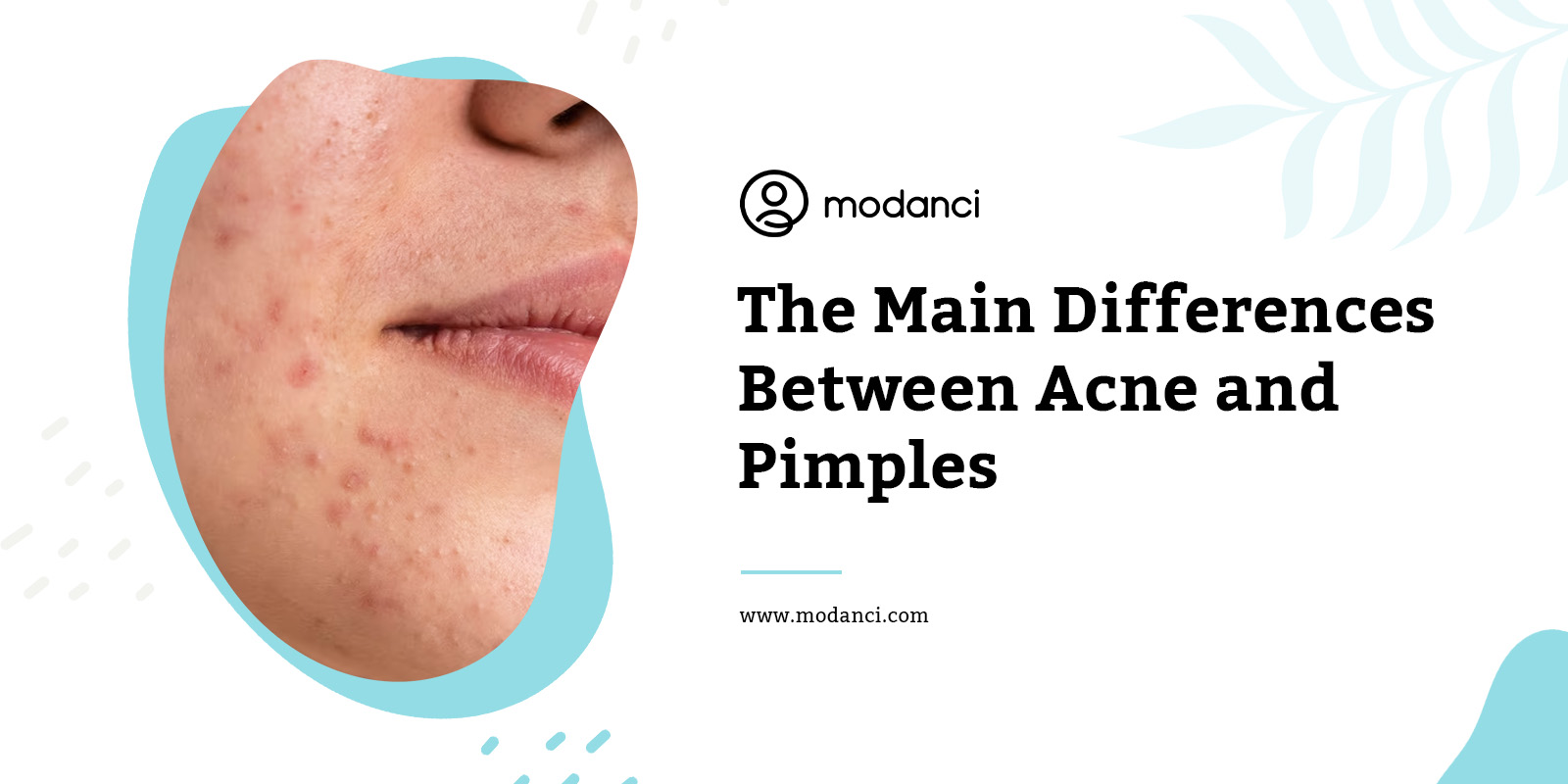The usage of the terms “Acne” and “Pimples” interchangeably has become so widespread that they are nearly synonymous. But are they the same thing? A short answer is: No. Acne and pimples may seem to be the same thing, but they are different terms. In this blog post, we aim to clarify the differences between acne and pimples and dispel any misconceptions. Stay with us as we explore both conditions in detail.
Acne and pimples vary in their nature, with acne considered a disease, while pimples serve as one of its symptoms. Acne develops when skin pores become clogged due to an excess of sebum, dead skin cells, and pollutants. This condition can manifest during adolescence or adulthood and is not confined to a specific skin type.
What is Acne?
Acne occurs when excess production of sebum in the skin’s oil glands and hair follicles leads to the persistent appearance of pimples. The skin is equipped with small openings or pores that allow oil and sweat to reach the surface from their respective glands beneath. These oil glands continuously secrete a sticky substance called sebum to protect the skin from moisture loss.
A canal connects the sebaceous glands and pores, usually with fine hair growing outward. However, when sebum, dead skin cells, dust, grime, bacteria, and other impurities become trapped together, they form a plug within the follicle. Gradually, bacteria within these plugs trigger inflammation, resulting in redness and swelling—these classic signs are called pimples.
Causes of Acne
While the exact cause of acne remains uncertain, dermatologists suggest that certain factors or circumstances can trigger or worsen acne, including:
- Hormonal changes, such as those occurring during adolescence, menstrual cycles, and pregnancy.
- Imbalance in the Thyroid Hormone
- Infections resulting from squeezing or picking at pimples.
- Use of harsh chemicals or toxic substances on the skin.
- Overuse of cosmetics or makeup products.
- Bacterial infections.
- Weather conditions, particularly high humidity.
- Stress.
- Exposure to environmental aggressors.
- Overly aggressive scrubbing of the skin.
- Certain medications that may lead to acne as a side effect.
- Consuming junk food and sugary cola drinks.
Acne can significantly impact the self-esteem of both men and women due to its unappealing nature. Therefore, it is crucial to adopt a skincare regimen focused on pimple or acne removal.
What are Pimples?
Acne manifests in various stages, each exhibiting distinct signs. Among these signs are pimples, characterized by pus-filled lesions and inflammation. Pimples occur when clogged pores burst due to the accumulation of dust and dead skin cells. This creates an environment where bacteria can thrive, leading to inflammation and the release of oils onto the skin’s surface.
Causes
The primary cause of facial pimples in teenagers and young adults is hormonal changes. For some individuals, these pimples can persist into their twenties and beyond unless they adopt a more effective skincare regimen. It’s worth noting that acne can even affect infants. Those with sensitive skin types, such as oily or dry skin, are particularly prone to developing pimples.
Types
There are various types of pimples, including whiteheads, blackheads, cysts, nodules, papules, and pustules. Among them, whiteheads and blackheads are considered milder compared to cysts and nodules, which tend to be more painful and affect the deeper layers of the skin.
Whiteheads, also known as closed comedones, manifest as small, white bumps on the skin’s surface. On the other hand, blackheads appear black due to the oxidation of dust and debris in the pores when exposed to air. Papules are common-sized pimples that can be easily treated. Conversely, pustules are larger, swollen pimples that often necessitate professional treatment.
Main Difference
Distinguishing between acne and pimples based on appearance and location can be helpful in understanding the nature of the skin condition. Here are some characteristics that can help you tell the difference:
1. Appearance
- Acne
Acne is a broader skin condition that includes various types of blemishes such as whiteheads, blackheads, papules, pustules, nodules, and cysts. These blemishes may vary in size, color, and texture. Acne typically presents with a mix of these different types of blemishes on the skin.
- Pimples
Pimples, on the other hand, specifically refer to the small, red, inflamed bumps on the skin caused by clogged pores and bacterial infection. They are a specific type of acne, and they tend to be uniform in appearance, appearing as small red bumps with or without a white center.
2. Location on the Body
- Acne
Acne can appear on the face, neck, chest, back, shoulders, and even other parts of the body. It tends to be more widespread and may involve multiple types of blemishes in different areas.
- Pimples
Pimples are a common form of acne and are often localized on the face, particularly on the forehead, cheeks, chin, and nose. They may occasionally occur on the back and chest as well, but they are most commonly seen on the facial area.
In summary, acne is a comprehensive skin condition encompassing various types of blemishes occurring in different body areas. Pimples are one specific type of blemish that usually appears on the face but can also occur on other body parts. If you notice a wide range of blemishes on different areas of your skin, it is likely to be acne. However, if you predominantly have small, red, inflamed bumps on your face, it’s more likely to be pimples, which are a subset of acne. It’s always best to consult an Ayurvedic Physician for a precise diagnosis and appropriate treatment.
Conclusion
In conclusion, while understanding the difference between “Acne” and “Pimples” can be helpful, what truly matters is maintaining a robust skincare routine. Acne serves as an umbrella term, encompassing various skin conditions, with pimples being one of its symptoms.Acne can appear on the face, neck, chest, back, and shoulders, resulting in various blemishes across different areas. Pimples, a common form of acne, are mainly found on the face—forehead, cheeks, chin, and nose—with occasional occurrences on the back and chest. However, using these terms interchangeably may be ok as long as you prioritize your skin’s health.
At Modanci, we are committed to providing personalized solutions tailored to your specific skin type and unique prakruti. Our aim is to help you achieve and maintain healthy, glowing skin through customized skincare approaches. Remember, investing in proper skincare and seeking expert advice when needed will ultimately contribute to your skin’s well-being and radiance.
FAQs
1. What are acne and pimples, and how do they differ from each other?
Acne and pimples can be distinguished by their relationship, as acne is a medical condition, while pimples are merely a symptom of it.
2. What are some common causes of acne and pimples, and how can they be prevented?
Common causes of acne and pimples include excessive sebum production, hormonal imbalances, bacterial infections, and diet. Preventive measures include regular cleansing, using non-comedogenic products, maintaining a balanced diet, managing stress, and avoiding squeezing or popping pimples. Seeking professional advice is advisable for persistent or severe cases.
3. How can I tell the difference between acne and pimples based on appearance and location on the body?
Acne includes various blemishes in different areas of the body, while pimples specifically refer to small red bumps on the face, primarily on the forehead, cheeks, chin, and nose. Consulting an Ayurvedic Physician is best for a precise diagnosis and treatment.
4. Can acne and pimples be treated with the same skincare products and routines, or are there specific treatments for each?
Acne and pimples can be treated with similar skincare products and routines due to their shared causes. Both benefit from regular cleansing, exfoliation, and moisturizing. Over-the-counter creams with ingredients like benzoyl peroxide or salicylic acid are effective. However, severe cases may require dermatologist-prescribed treatments like antibiotics or retinoids. Always seek professional advice for personalized care.
Read More:




